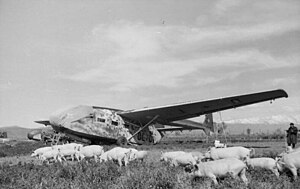Loading AI tools
Transport glider used by the Luftwaffe during World War II From Wikipedia, the free encyclopedia
The Gotha Go 242 was a transport glider used by the Luftwaffe during World War II. It was an upgrade over the DFS 230 in both cargo/troop capacity and flight characteristics. It saw limited combat action. There were multiple glider variants, and it became the basis for a transport aircraft, the: Gotha Go 244.
| Gotha Go 242 | |
|---|---|
 Gotha Go 242 in Grosseto, 1943 | |
| General information | |
| Type | Transport glider |
| Manufacturer | Gothaer Waggonfabrik |
| Designer | Albert Kalkert |
| Primary user | Luftwaffe |
| Number built | 1,528[1] |
| History | |
| Introduction date | 1941 |
| First flight | 1941 |
This section needs additional citations for verification. (January 2021) |
The Go 242 was designed by Dipl-Ing Albert Kalkert in response to a Reichsluftfahrtministerium (RLM) requirement for a heavy transport glider to replace the DFS 230 then in service. The requirement was for a glider capable of carrying 20 fully laden troops or the equivalent cargo.
The aircraft was a high-wing monoplane with a simple square-section fuselage ending in clamshell doors used to load cargo.[2] The empennage was mounted on twin booms linked by a tailplane. The fuselage was formed of steel tubing covered with doped fabric. The flight characteristics of the design were better than those of the DFS 230.
Cargo versions of the glider featured a hinged rear fuselage loading ramp that could accommodate a small vehicle such as a Kübelwagen or loads of similar size and weight.[2]
Two prototypes flew in 1941 and the type quickly entered production. A total of 1,528 were built, 133 B-1 to B-5s were converted[1] to the Go 244, with two 500 kW (670 hp) Gnome-Rhône 14M engines, (a paired -04 and -05 rotating in opposite directions), fitted to forward extensions of the tail booms.
The Go 242 was tested with various rockets for overloaded take offs. A rack of four 470 N (106 lbf) Rheinmetall-Borsig 109-502 rockets mounted on the rear of the cargo compartment was tested but not used operationally. A second rocket, called "R-Gerät", also used with the glider, was a liquid-fuelled Walter HWK 109-500A (R I-203) Starthilfe; a podded monopropellant (T-Stoff, stabilised high test peroxide), rocket engine mounted beneath each wing and jettisoned after take-off, parachuting down to be recycled.

In service, Go 242s were towed into the air by Heinkel He 111s or Junkers Ju 52s, and were occasionally fitted with RATO equipment. Most saw service in the Mediterranean, North Africa and Aegean. Ju 87D-2s had strengthened rear fuselage and combined tailwheel and hook for towing the Go 242.[citation needed]
A few gliders, the Go 242 C-1 variant, were constructed with a flying boat-style hull allowing water landings. It was proposed that some carry a small catamaran assault boat with a 1,200 kg (2,600 lb) explosive charge suspended between its hulls. The proposed mission profile was for the pilot to land near an enemy ship and transfer to the assault boat, setting off at high speed for the enemy ship and locking the controls before bailing out.[3][2]

Data from Die Deutsche Luftruestung 1933–1945 Vol.2 – Flugzeugtypen Erla-Heinkel[4]
General characteristics
Performance
Armament
Related development
Aircraft of comparable role, configuration, and era
Related lists
Seamless Wikipedia browsing. On steroids.
Every time you click a link to Wikipedia, Wiktionary or Wikiquote in your browser's search results, it will show the modern Wikiwand interface.
Wikiwand extension is a five stars, simple, with minimum permission required to keep your browsing private, safe and transparent.